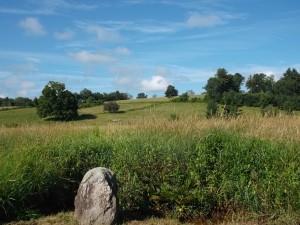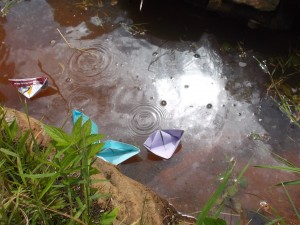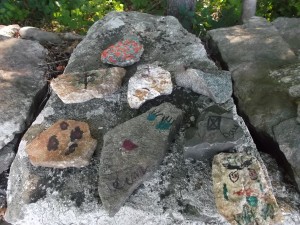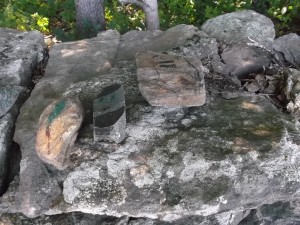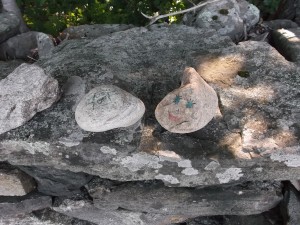I’m not sure how I heard about it — an urgent email message from one of the conservation organizations I belong to? — but I marked on my calendar that I should be in Greenfield this evening to attend a scoping session conducted by FERC, the Federal Energy Regulatory Commission. Shortly before 6:30, when the meeting was scheduled to begin, I pulled into the parking lot of the Greenfield Middle School on Federal Street. The partisans were out in force, both for and against, and I ended up signing a couple of petitions (you probably know which side I’m on) before I went inside to find a seat.
We’ve been sweating through some very hot days recently, and not surprisingly, the auditorium was stifling, the heat exacerbated by the hundreds of people packed inside. Some clever person thought of handing out fans, green paper fans with the words “FERC Do Your Job” printed in large letters; these helped a lot in moving the air around.
John Peconom, a FERC project manager, opened the meeting around 6:30, and warned that it would probably run for hours, as they felt it was important that everyone have a chance to speak. A stenographer would transcribe all the statements, he said, and the proceedings would be transmitted live on WHMP and also taped for broadcast on community cable TV. The first group of speakers would be town officials, then individual citizens who put their names on the list would be invited to the microphone. Town officials would have a maximum of four minutes for their remarks and private citizens three.
I knew a little about the project, particularly from comments I heard at the Mass Land Trust conference I attended in March, but I was a bit surprised at the extent of opposition to the project and the vehemence expressed. The project, officially known as Northeast Energy Direct, is a proposal by Tennessee Gas Pipeline LLC to build a high-pressure transmission pipeline through New York state, New Hampshire, and Massachusetts, in order to bring natural gas from the Marcellus Shale Formation in Pennsylvania to a terminal hub in Dracut. The 412-mile pipeline would impact five states; in Massachusetts, the proposed route cuts through rural areas in the Berkshires and Franklin County and would pass under the Connecticut and Deerfield Rivers. North of Warwick, the route crosses the border into New Hampshire. The current plan also indicates that pipeline laterals, which are like subsidiary gas lines, are proposed for Worcester County, where I live. In addition to the pipeline itself, the project would require new compressor and meter stations.
Because this pipeline involves interstate commerce, it is federally regulated; a glossy brochure I picked up off the floor explains, “The Commission [FERC] approves the location, construction, and operation of interstate pipelines, facilities, and storage fields involved in moving natural gas across state boundaries.” The approval process goes something like this: gas company pre-files plans, scoping is conducted to determine environmental issues, applicant files FERC application, FERC issues notice of application, additional scoping is conducted if needed, FERC issues EA or Draft EIS, comments are reviewed, FERC issues Final EIS, Commission decides. The process can take years, as you might imagine.
I listened to the testimony of twenty people before I decided that I needed to leave for home. In order, these were:
- Keith Barnicle, on behalf of US Representative Jim McGovern
- Cynthia Brubaker, on behalf of State Representative Ellen Story
- Chris Capucci, on behalf of State Senators Rosenberg and Downing, State Representatives Kulik, Mark, Cariddi, and Whipps-Lee
- Carolyn Ness, Deerfield
- David Wolfram, Deerfield
- Jack Spanbauer, Northfield
- Tracy Rogers, Northfield
- Brian Noble, Northfield
- Joanne McGee, Northfield
- Meg Burch, Conway
- Jim Moore, Conway
- Linda Dunlavy, Franklin County Regional Planning Commission
- Walter Ramsey, Montague
- Nina Keller, Wendell
- Pat Cady, Wendell
- Lawrence Pruyne, Warwick
- Barbara Francis, Bernardston
- Marion Kelner, Greenfield
- Steve August, Mass Energy Siting Board
- Joe Graveline, Northfield
The arguments against the pipeline are legion. Construction of the pipeline would cause irreparable damage to natural, cultural, and historic sites. There would be continued risk to human health and safety from hazardous chemical leakage and possible explosions. In addition, the reliance on fossil fuel extraction contributes to greenhouse gas emissions and de-emphasizes investment in renewables. Opponents of the pipeline also state that there is no proven demand for this additional new capacity. As the website for opposition organization Stop NED summarized the issue:
A gas pipeline is being forced upon us that will take our property by eminent domain, tax us to pay for its construction, destroy our protected and treasured open spaces, increase the risk to our personal safety, and jeopardize our State’s ability to meet its carbon emission [reduction] commitments. We envision stopping the unnecessary pipeline and meeting our [future energy] needs by reducing our reliance on fossil fuels, increasing efficiency, expanding renewable technologies, and mandating repairs of existing infrastructure.
Other opposition groups, such as Mass Pipeline Awareness Network, No Fracked Gas in Mass, New Hampshire Pipeline Awareness, and Stop the New York Pipeline, make similar declarations.
The arguments for the project focus on jobs and industry. Supporters in the audience tonight included a number of union laborers who believe that the pipeline construction will create much needed jobs, and representatives from industry, who believe that the high price of energy in Massachusetts is a barrier to businesses seeking to relocate to the state.
Concerned citizens can find more information about the project by using the FERC library website: search for Docket “PF14-22” (exactly as in the quotation marks). The public is invited to comment prior to FERC’s preparation of an Environmental Impact Statement; instructions for doing so are available here.
